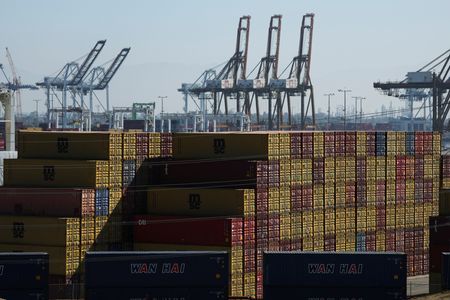By Lewis Krauskopf and Suzanne McGee
NEW YORK/LONDON (Reuters) -Global investors got a harsh reminder of the risks around trade tariffs and U.S. President Donald Trump’s deal-making on Saturday after he threatened fresh tariffs on his biggest trading partners in Europe and Mexico.
Trump said in social media posts on Saturday he would impose a 30% tariff on imports from Mexico and the European Union starting on August 1.
The announcement comes after weeks of talks with key U.S. trading allies that failed to reach a more comprehensive trade deal, and a week marked by heightened trade tensions after Trump issued new tariff announcements for a number of other countries, including Japan, South Korea, Canada and Brazil, as well as a 50% tariff on copper.
The European Union is the United States’ largest trade and investment partner and had hoped to reach a comprehensive trade agreement with the U.S. for the 27-country bloc.
Three EU officials told Reuters on Saturday that Trump’s 30% tariff threat is a negotiating tactic.
Michael Brown, a senior market strategist at Pepperstone in London, said it seemed to be a “escalate to de-escalate” strategy by Trump aimed at getting trading partners to negotiate and extract concessions.
The EU had been facing the threat of 50% U.S.
tariffs on its steel and aluminium exports, 25% on cars and car parts and 10% on most other products. The U.S. had also been looking into further tariffs on pharmaceuticals and semiconductors.
Brown said the risk was the European Union takes the new tariffs poorly and announces countermeasures that escalate trade tensions to levels in early April, when markets were whipsawed by Trump’s initial Liberation Day tariffs.
“Depending on what happens in the next 24 hours or so, I imagine that the knee-jerk move is euro-negative, eurozone asset-negative.
And then, as calmer heads prevail, it comes back to the fact that, is it just a negotiating gambit?,” he said.
Despite some modest rockiness this week, the benchmark S&P 500 ended down just 0.3% on the week and not far from record-high levels.
European stocks took a slight hit on Friday as markets waited for the promised letter on tariffs. The pan-European STOXX 600 index lost 1% and snapped a four-day winning streak, clocking its biggest single-day decline in over three months.
Mexico has more to lose, given the United States is its largest export market and the economy is already feeling the impact of the uncertainty over trade.
U.S. stocks have rebounded after plunging in April following Trump’s “Liberation Day” announcement of sweeping global tariffs. Trump had paused many of those steep tariffs but issued new levies this week with an August 1 date for them to go into effect.
The CBOE Volatility Index, Wall Street’s “fear gauge,” closed on Thursday at 15.78, its lowest closing level in nearly five months, although it moved back above 16 on Friday.
Karl Schamotta, chief market strategist with payments company Corpay in Toronto, said the stream of tariff announcements could reignite market concerns.
“At some point soon, it will become clear that Trump’s protectionist agenda has not been appropriately discounted in currencies, in asset prices, or in measures of volatility.”
“A moment of capitulation is coming, in financial markets, or in the White House itself,” Schamotta said.
While markets are less sensitive to headlines than a few months ago, “we will need some positive trade developments by the White House’s August 1 deadline to hold recent equity market gains,” Citi strategist Scott Chronert said in a note on Friday.
The current weighted average tariff in the U.S.
is about 16%, up from 2.5% at the start of the year, UBS economists said on Friday. The rate would rise to about 18%, including the country tariffs announced in this week’s letters, UBS said in a note.
(Reporting by Lewis Krauskopf, Saqib Ahmed, Suzanne McGee and Amanda Cooper; Editing by Rod Nickel, Vidya Ranganathan and Diane Craft)










